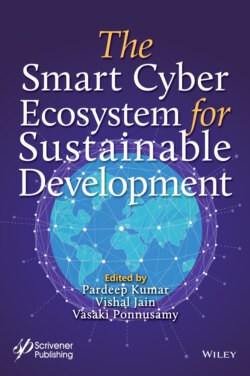Читать книгу The Smart Cyber Ecosystem for Sustainable Development - Группа авторов - Страница 14
1.1 Introduction
ОглавлениеThere are several motivated factors that tell us why the voyage of IoT is important in the ocean of technology. Current internet service basically provides a connection of computers and computing devices, whereas the Internet of Things (IoT) has expanded its scope from computers and computing devices to other things around us. IoT interconnects physical objects around us such as at home it can be communicated with lights, fans, air conditioners, refrigerators, microwave ovens, and other Bluetooth-operated devices, and at the workplace, it can be communicated with internet operated machines. In the recent era, such “Things” connected to the internet have crossed over twenty billion. Such things using embedded electronics are going to connect other things around them depending on the application requirements and thus construct a much bigger Inter-network of Things than that of the current internet of computers and computing devices called the Internet of Things (IoT). To do so, IoT devices have to deal with a challenge of interoperability, that means how such different objects can perform inter-communication with each other. So, this is the integral visualization of the IoT.
The other motivated factor in IoT technology implementation is of its low-cost IoT hardware. In IoT, connection of low-cost sensors with cloud platforms gives revolutionary results in this technological era. Using a legitimate merger of these technologies, we can track, analyze, and respond to operational data at a large scale. So, this feature leads toward the end of legacy closed, static, and bounded systems technology and creates a new paradigm of omnipresent connectivity. Such omnipresent connectivity enables communication and exchanges useful information between and with everyday objects around us in order to improve quality of human life. When objects can sense the environment and communicate, they become powerful tools for understanding complexity within it. Such smart objects that can interact with human beings are likely to be interacting more with each other automatically (without human intervention) and updating themselves their daily schedules [1].
Such a phenomenon in the 2000s was heading into a new era of ubiquity, the fact of appearing everywhere internet connectivity is not only serving for Anywhere, Anytime but it also gives the surface of connecting Anything. So, this concept will remove a separation between the real world (physical world) and an imaginary world (internet) resulting that real-world interest should be able to get access to online. In this online access, human beings are very less as internet traffic generators and receivers compared to the things (devices) around us. So, as per the Gartner Research, we can define IoT as, “The Internet of Things (IoT) is the network of physical objects that contain embedded technology to communicate and sense or interact with their internal states or the external environment” [30].
